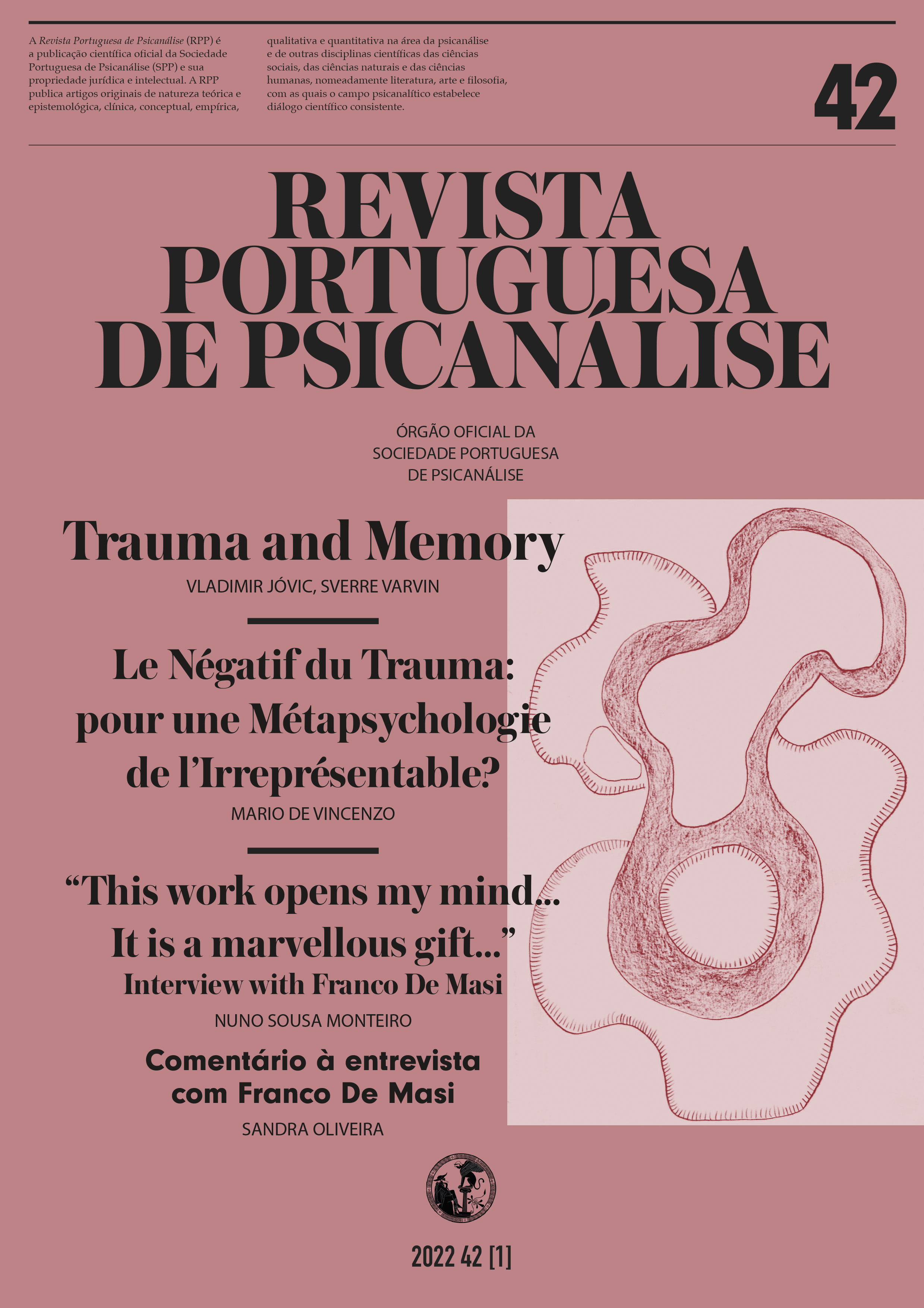En las Fronteras de Cronos: Del Tiempo del Trauma a la Creación de un Tiempo Inédito

Abstract
In the Frontiers of Cronos: From the Time of Trauma to the Creation of an Unprecedented Time
This article presents a conceptual overview of the different ways of thinking temporality and the traumatic, where it is possible to perceive that the ability to find evidence of the indissoluble link between subject-trauma-time is clearly a central emergent of psychoanalytic identity and psychoanalytic work. In this sense, the consideration of a singular temporality represents one of its most persistent acts of rebellion against the voracity of Chronos. From the conceptualization of unconscious processes, Freud dismantles the certainty of causality and explanation, striking an indelible mark on this pretension. The potentiality of new representations and conditions of inscription of experiences -and, therefore, new subjective trajectories-, where the analyst acts creating a past/future for a subject that does not yet exist, implies affirming not only that subjective time cannot be measured, but that it can be re-created in analysis, in the transference.
Keywords
Temporality, Trauma, Subjectivization, Memory
Author Biography
Silvia Raquel Acosta
Psicanalista, membro da Sociedade Portuguesa de Psicanálise
References
- Bion, W. (1990). A memoir of the future. London: Karnac. (Original publicado en 1975)
- Cassin, B. (1986). Le Plaisir de parler. Études de sophistique comparée. Collection Arguments. Les Éditions de Minuit
- Dahl, G. (2011). Los dos vectores temporales de Nachträglichkeit en el desarrollo de la organización del yo: la importancia del concepto para la simbolización de los traumas y ansiedades sin nombre. J. psicanal. [online]. 44(80), 95-114. ISSN 0103-5835.
- Faimberg, H. (2016). La “situación todavía no advenida” en Fragmento de un análisis de Winnicott: “su padre nunca le hizo el honor de”…aún en Psychoanalytic Quartely en español, Jarast G (compilador) Nro.1 . EA Editorial.
- Faimberg, H., & Corel, A. (1989). Repetition and surprise. In The Telescoping of Generations: Listening to the Narcissistic Links Between Generations, by H. Faimberg. London/New York: Routledge, 2005
- Foucault, M (1983) “Structuralisme et poststructuralisme”. Telos, Vol. XVI, no 55, primavera, 195-211.
- Freud, S. (1991). Estudios sobre la Histeria. OC, Tomo II, Amorrortu. (Trabajo original de 1893 publicado en 1895).
- Freud, S. (1991). Estudios sobre la Histeria. OC, Tomo III: Amorrortu, (Trabajo original publicado en 1895)
- Freud, S. (1991). Fragmentos de la correspondencia con Fliess: Carta 52. En Freud, S. (1895) Vol. I. pp 164. OC, Amorrortu. (Trabajo original publicado en 1896)
- Freud, S. (1991). Sobre el mecanismo psíquico de la desmemoria. OC, Tomo III: Amorrortu. (Trabajo original publicado en 1898)
- Freud, S. (1991). La interpretación de los sueños. OC, Tomo V: Amorrortu. (Trabajo original publicado en 1900)
- Freud, S. (1991). Totem y Tabú. OC, Tomo XIII: Amorrortu. (Trabajo original de 1913 publicado en 1914)
- Freud, S. (1991). Recuerdo, repetición y elaboración. OC, Tomo XIII: Amorrortu. (Trabajo original publicado en 1914)
- Freud, S. (1991). Pegan a un niño. OC, Tomo XIX: Amorrortu. (Trabajo original publicado en 1919)
- Freud, S. (1995). Nota sobre la «pizarra mágica, OC, Tomo XIX: Amorrortu. (Trabajo original de 1924 publicado en 1925)
- Freud, S. (1995). El malestar en la cultura en OC, Tomo XXI. Buenos Aires: Amorrortu. (Trabajo original publicado en 1929)
- Freud, S. (1995). Moises y la religión monoteísta, OC, Tomo XXIII: Amorrortu. (Trabajo original publicado en 1937)
- Freud, S. (1995). Construcciones en análisis. OC, Tomo XXIII: Amorrortu, (Trabajo original publicado en 1937)
- Freud. S. (2000). Sobre los recuerdos encubridores. OC, Tomo III. Amorrortu. (Trabajo original publicado en 1899)
- Freud. S. (2000). Psicopatología de la vida cotidiana, OC, Tomo VI: Amorrortu, (Trabajo original publicado en 1901)
- Green, A. (1996a). ¿Qué clase de investigación para el psicoanálisis? En Sandler, J., Sandler, A. M., Davies, R., et al. La investigación psicoanalítica clínica y observacional: raíces de una controversia, André Green y Daniel Stern. Londres, Karnac, 2000
- Green, A. (2002). La Diacronia en Psicoanálisis. Amorrortu
- Heidegger, M. (1953). Introduction to Metaphysics. (Trad.) Gregory Fired & Rochald Port. New Haven: Yale University Press.
- Khan, M. (1978). Vicissitudes de l’Etre, du connaitre et de l’éproucer dans la situation analytique. En “Le Soi Caché”. (The Privacy of the Self). Ed. Gallimard.
- Lacan, J. (1975). Seminario 23. El Sinthome, (p. 145). Buenos Aires: Paidós.
- Le Poulichet, S. (2014). La Obra del Tiempo en Psicoanálisis. Amorrortu.
- Mearns, W. H. (1899). Antigonish. En Colombo, J.R., Canadian Literary Landmarks. Dundurn Press, 1984.
- Moreno, J. (2018). En F. Gomez y J. M. Tausik, (Eds.), Psicoanálisis Latinoamericano Contemporáneo. Buenos Aires: APA Editorial.
- Von Wright, G. H. (1971). Explicación y comprensión. Madrid: Alianza.